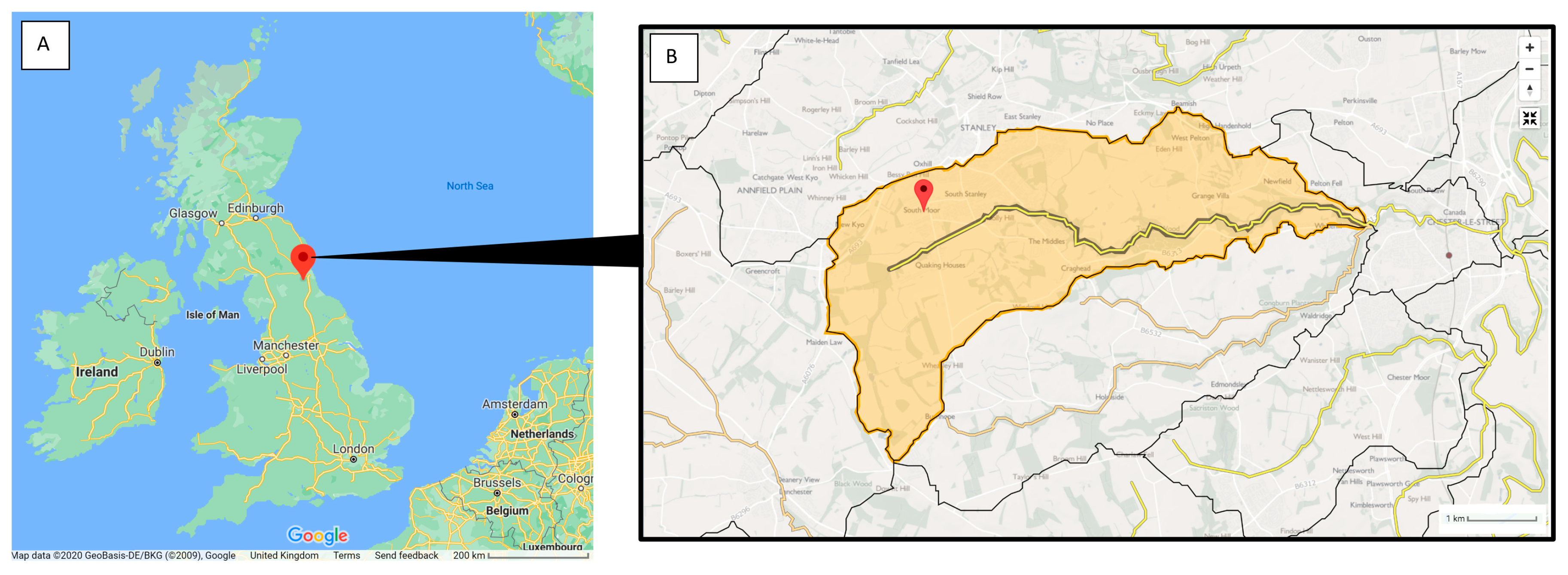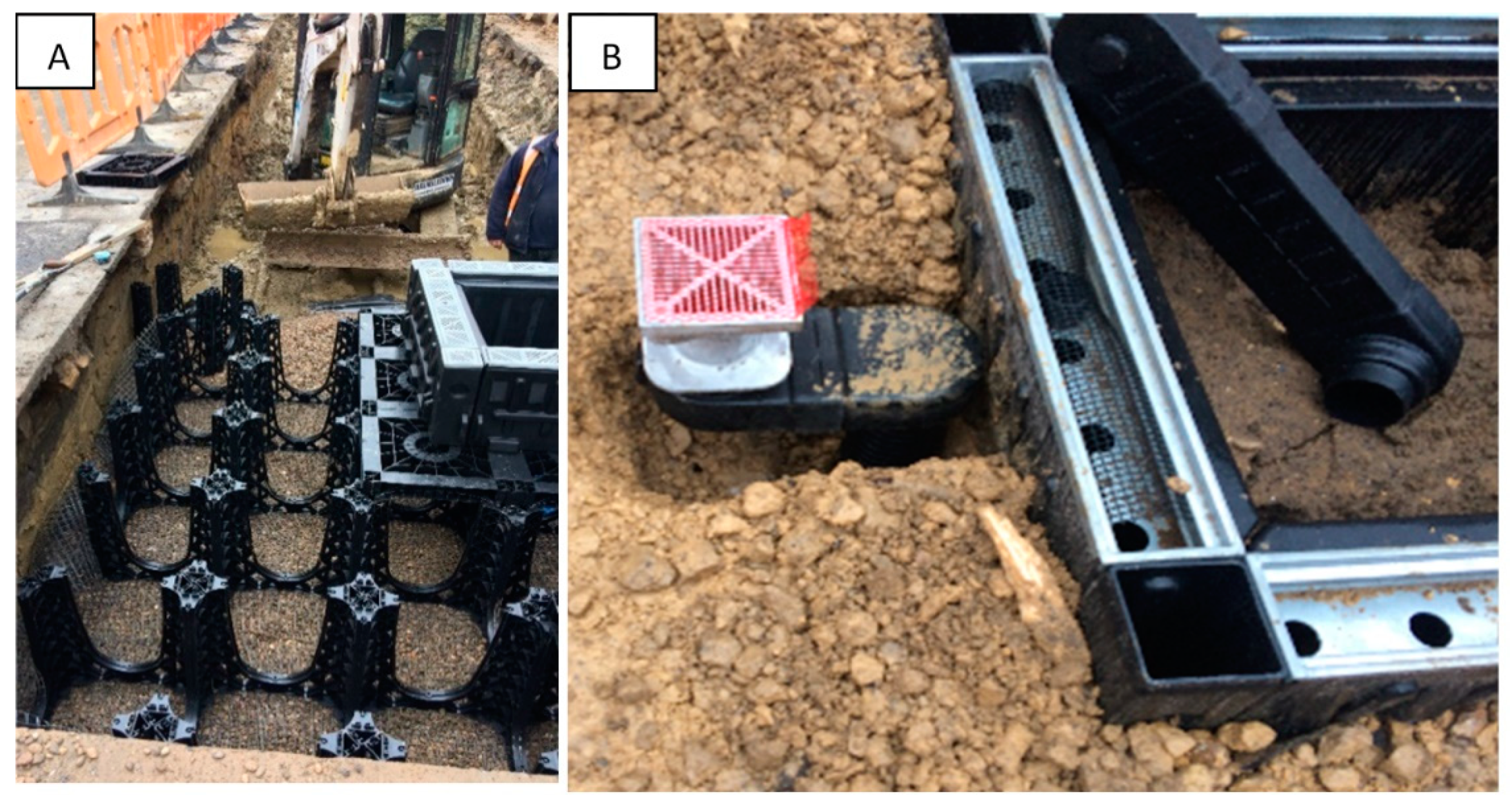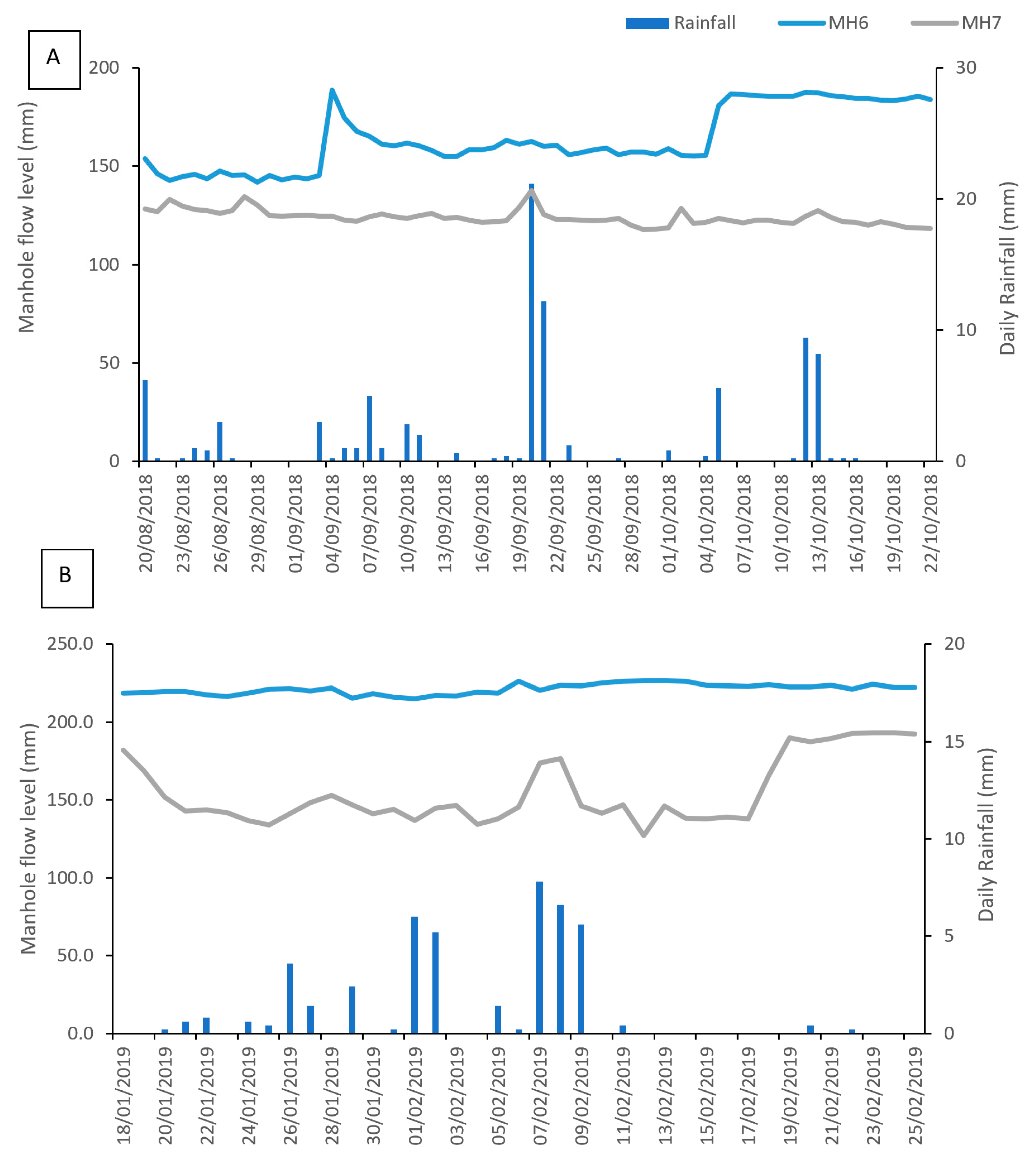Assessing the Effectiveness of Sustainable Drainage Systems (SuDS): Interventions, Impacts and Challenges
Abstract
:1. Introduction
1.1. Current Understanding and Evaluation of SuDS
1.2. The Relationship between SuDS and Health and Wellbeing
1.3. Complexities of Implementing SuDS
2. Materials and Methods
2.1. Conceptual Framework
2.2. Study Area
2.3. SuDS Interventions
2.4. Monitoring
2.5. The Roles of Stakeholders
2.6. Statistical Analyses
3. Results
3.1. Weather
3.2. Reductions in Runoff
3.3. Engagement and Adoption
“Through partnership working, the demonstration site at South Moor will allow small, innovative businesses to test new water and energy saving products in a live environment. Crucially the project includes input from 300 residents to shape solutions and deliver immediate impact for the local community”.
“I think they’re excellent additions to peoples’ yards and it would be fantastic if we could get more of them in.”
“I’m very happy with it. It’s nice to look at from my window, I like the plants that were planted in there, and I re-varnished the wood, because I decided I wanted something a little bit darker.”
4. Discussion
4.1. Effectiveness of SuDS
4.2. Challenges for Data Capture
4.3. Social Perceptions of SuDS
5. Conclusions
- (1)
- Coordinating a project with multiple drivers, stakeholders and novel technologies presents challenges, but multi-institution collaboration ensures there is the resource, capacity and buy-in required to support the deployment of SuDS.
- (2)
- There remains a need to evidence the performance and benefits of SuDS through long-term monitoring. However, the quality of wireless telecommunication services underpinning the transfer of data may limit what can be collected. Advances in novel satellite communication technologies may provide a route to obtaining high quality telemetered data in real time in rural or less-connected locations.
- (3)
- Whilst there is a growing interest in more innovative or integrated technologies in the SuDS community, we need to ensure this translates to the local communities too. Co-creating solutions, which consider how and why local residents might engage with water infrastructure practically, will lead to technical solutions that better align with community aspirations and are more likely to be accepted and maintained in the long-term.
- (4)
- The difficulties encountered in obtaining robust data to evidence the performance of SuDS at the street scale illustrates some of the reasons why evaluation of SuDS is not as extensive as researchers and practitioners would like.
- (5)
- It is likely to be more straightforward to design and deliver evaluation of SuDS in new developments or non-real world test sites, but this is unlikely to deliver a holistic understanding of how SuDS work in much of our urban environments.
Author Contributions
Funding
Acknowledgments
Conflicts of Interest
References
- Chocat, B.; Krebs, P.; Marsalek, J.; Rauch, W.; Schilling, W. Urban drainage redefined; from stormwater removal to integrated management. Water Sci. Technol. 2001, 43, 61–68. [Google Scholar] [CrossRef] [PubMed]
- Fletcher, T.D.; Andrieu, H.; Hamel, P. Understanding, management and modelling of urban hydrology and its consequences for receiving waters; A state of the art. Adv. Water Resour. 2013, 51, 261–279. [Google Scholar] [CrossRef]
- Fletcher, T.D.; Shuster, W.; Hunt, W.F.; Ashley, R.; Butler, D.; Arthur, S.; Trowsdale, S.; Barraud, S.; Semadeni-Davies, A.; Bertrand-Krajewski, J.; et al. The evolution and application of terminology surrounding urban drainage. Urban Water J. 2015, 12, 525–542. [Google Scholar] [CrossRef]
- Woods-Ballard, B.; Kellagher, R.; Martin, P.; Jefferies, C.; Bray, R.; Shaffer, P. The SUDS Manual; CIRIA C697; Construction Industry Research and Information Association: London, UK, 2007. [Google Scholar]
- CIRIA. Sustainable Urban Drainage Systems—Best Practice Manual for England, Scotland, Wales and Northern Ireland; CIRIA Report No. CR086A; CIRIA: London, UK, 2001. [Google Scholar]
- CIRIA. Sustainable Urban Drainage Systems—Design Manual for Scotland and Northern Ireland; CIRIA Report No. C521; CIRIA: Dundee, Scotland, 2000. [Google Scholar]
- DEFRA. Non-Statutory Technical Standards for Sustainable Drainage Systems. Available online: https://assets.publishing.service.gov.uk/government/uploads/system/uploads/attachment_data/file/415773/sustainable-drainage-technical-standards.pdf (accessed on 31 March 2020).
- Water Environment and Water Services Act; Scottish Government: Edinburgh, Scotland, 2003. Available online: https://www.legislation.gov.uk/asp/2003/3/contents (accessed on 31 March 2020).
- CIRIA. Overview of SuDS Performance. Information Provided to Defra and the EA. Draft. Available online: www.susdrain.org/files/resources/evidence/overview_of_suds_performance_2009_.pdf (accessed on 24 March 2020).
- Garofalo, G.; Giordano, A.; Piro, P.; Spezzano, G.; Vinci, A. A distributed real-time approach for mitigating CSO and flooding in urban drainage systems. J. Netw. Comput. Appl. 2017, 78, 30–42. [Google Scholar] [CrossRef]
- Lashford, C.; Charlesworth, S.; Warwick, F.; Blackett, M. Deconstructing the Sustainable Drainage Management Train in Terms of Water Quantity—Preliminary Results for Coventry, UK. Clean Soil Air Water 2014, 42, 187–192. [Google Scholar] [CrossRef]
- Sustainable Urban Drainage Systems (SUDS) in Scotland: Assessment of Monitoring and Maintenance within Local Authorities and Scottish Water. Available online: https://www.climatexchange.org.uk/media/3239/sustainable_urban_drainage_systems_in_scotland.pdf (accessed on 31 March 2020).
- Perales-Momparler, S.; Andrés-Doménech, I.; Hernández-Crespo, C.; Vallés-Morán, F.; Martín, M.; Escuder-Bueno, I.; Andreu, J. The role of monitoring sustainable drainage systems for promoting transition towards regenerative urban built environments: A case study in the Valencian region, Spain. J. Clean. Prod. 2017, 163, 113–124. [Google Scholar] [CrossRef]
- Brown, R.R.; Farrelly, M.A. Delivering sustainable urban water management: A review of the hurdles we face. Water Sci. Technol. 2009, 59, 839–846. [Google Scholar] [CrossRef]
- Abbott, C.L.; Comino-Mateos, L. In Situ Performance Monitoring of an Infiltration Drainage System and Field Testing of Current Design Procedures. Water Environ. J. 2001, 15, 198–202. [Google Scholar] [CrossRef]
- Adaptation to Climate Change Using Green and Blue Infrastructure. A Database of Case Studies. Available online: http://orca.cf.ac.uk/64906/1/Database_Final_no_hyperlinks.pdf (accessed on 24 March 2020).
- Melville-Shreeve, P.; Cotterill, S.; Grant, L.; Arahuetes, A.; Stovin, V.; Farmani, R.; Butler, D. State of SuDS delivery in the United Kingdom. Water Environ. J. 2018, 32, 9–16. [Google Scholar] [CrossRef]
- Eggermont, H.; Balian, E.; Azevedo, J.M.; Beumer, V.; Joachim, C.; Lamarque, P.; Reuter, K.; Smith, M.; van Ham, C.; Weisser, W.; et al. Nature-based solutions: New influence for environmental management and research in Europe. GAIA 2015, 24, 243–248. [Google Scholar] [CrossRef]
- Cohen-Shacham, E.; Walters, G.; Janzen, C.; Maginnis, S. Nature-Based Solutions to Address Global Societal Challenges; IUCN: Gland, Switzerland, 2016. [Google Scholar]
- European Union. Towards an EU Research and Innovation Policy Agenda for Final Report of the Horizon 2020 Expert Group on ‘Nature-Based Solutions and Re-Naturing Cities’ (Full Version). Available online: https://ec.europa.eu/research/environment/index.cfm?pg=nbs (accessed on 4 January 2018).
- Arets, R.; Honnay, O.; Van Nieuwenhuyse, A. Biodiversity and Human Health: Mechanisms and Evidence of the Positive Health Effects of Diversity in Nature and Green Spaces. Br. Med. Bull. 2018, 127, 5–22. [Google Scholar] [CrossRef] [PubMed] [Green Version]
- Hartig, T.; Mitchell, R.; de Vries, S.; Frumkin, H. Nature and Health. Annu. Rev. Public Health 2014, 35, 207–228. [Google Scholar] [CrossRef] [PubMed] [Green Version]
- Markevych, I.; Maier, W.; Fuertes, E.; Lehmann, I.; von Berg, A.; Bauer, C.-P.; Koletzko, S.; Berdel, D.; Sugiri, D.; Standl, M.; et al. Neighbourhood greenness and income of occupants in four German areas: GINIplus and LISAplus. Urban For. Urban Green. 2017, 21, 88–95. [Google Scholar] [CrossRef] [Green Version]
- Dalton, A.M.; Jones, A.P.; Sharp, S.J.; Cooper, A.J.; Griffin, S.; Wareham, N.J. Residential neighbourhood greenspace is associated with reduced risk of incident diabetes in older people: A prospective cohort study. BMC Public Health 2016, 16, 1171. [Google Scholar] [CrossRef] [PubMed] [Green Version]
- Westling, E.L.; Lerner, D.N.; Sharp, L. Using secondary data to analyse socio-economic impacts of water management actions. J. Environ. Manag. 2009, 91, 411–422. [Google Scholar] [CrossRef] [Green Version]
- Piacentini, S.M.; Rossetti, R. Attitude and Actual Behaviour towards Water-Related Green Infrastructures and Sustainable Drainage Systems in Four North-Western Mediterranean Regions of Italy and France. Water 2020, 12, 1474. [Google Scholar] [CrossRef]
- Vilcan, T.; Potter, K. Delivering sustainable drainage systems through the English planning system: A proposed case of institutional void. J. Flood Risk Manag. 2019, 13, e12591. [Google Scholar] [CrossRef] [Green Version]
- Potter, K.; Vilcan, T. Managing urban flood resilience through the English planning system: Insights from the ‘SuDS-face’. Philos. Trans. R Soc. A 2020, 378, 20190206. [Google Scholar] [CrossRef] [Green Version]
- Juntti, M.; Russel, D.; Turnpenny, J. Evidence, politics and power in public policy for the environment. Environ. Sci. Policy 2009, 12, 207–215. [Google Scholar] [CrossRef]
- Bracken, L.J.; Oughton, E.A. Making sense of policy implementation: The construction and uses of expertise and evidence in managing freshwater environments. Environ. Sci. Policy 2013, 30, 10–18. [Google Scholar] [CrossRef] [Green Version]
- Warming Your Home. Improving Your Street. Available online: https://swiiproject.co.uk/ (accessed on 23 March 2020).
- Bracken, L.J.; Cockshut, L.; Taylor, J.; Cotterill, S. The role of innovation in advancing understanding of hydrological processes. Hydrol. Process. 2020, 34, 1–13. [Google Scholar] [CrossRef]
- Stanley Area Action Partnership—2017 Statistical Profile. County Durham Partnership. Available online: http://www.countydurhampartnership.co.uk/media/22702/Stanley-Area-Action-Partnership-Profile-2017/pdf/StanleyAAPProfile2017.pdf (accessed on 4 January 2018).
- Environment Agency. Catchment Data Explorer—Twizell Burn from Source to Cong Burn. Available online: http://environment.data.gov.uk/catchment-planning/WaterBody/GB103024077590 (accessed on 26 March 2019).
- Twizell Burn Green Infrastructure Action Plan. Groundworks NE & Cumbria. Available online: https://issuu.com/groundworkne/docs/jp140501_final_online_7977e75c9a910e (accessed on 26 March 2019).
- Map of United Kingdom, Google Maps. Available online: https://www.google.com/maps/@54.7062174,-7.388868,5.54z (accessed on 11 November 2020).
- Butler, D.; Digman, C.; Makropoulos Davies, J.W. Urban Drainage, 4th ed.; CRC Press: Boca Raton, FL, USA; Taylor & Francis Group: Boca Raton, FL, USA, 2018; pp. 473–474. [Google Scholar]
- Rizzo, A.; Bresciani, R.; Masi, F.; Boano, F.; Revelli, R.; Ridolfi, L. Flood reduction as an ecosystem service of constructed wetlands for combined sewer overflow. J. Hydrol. 2018, 560, 150–159. [Google Scholar] [CrossRef]
- Fairhurst. South Moor Surface Water Management; Fairhurst: Durham, UK, 2015. [Google Scholar]
- Met Office. UK Climate—Historic Station Data Durham. Available online: https://www.metoffice.gov.uk/pub/data/weather/uk/climate/stationdata/durhamdata.txt (accessed on 26 March 2019).
- Stanley East Kyo Farm Rain Gauge January 2018–2019. Available online: https://www.gaugemap.co.uk/#!Map/Summary/9618/4985/2018-01-01/2019-01-31 (accessed on 24 August 2020).
- Koutroumpis, P.; Leiponen, A. Crowdsourcing mobile coverage. Telecommun. Policy 2016, 40, 532–544. [Google Scholar] [CrossRef]
- Zuniga-Teran, A.A.; Staddon, C.; de Vito, L.; Gerlak, A.K.; Ward, S.; Schoeman, Y.; Hart, A.; Booth, G. Challenges of mainstreaming green infrastructure in built environment professions. J. Environ. Plan. Manag. 2020, 63, 710–732. [Google Scholar] [CrossRef]
- Bastien, N.; Arthur, S.; Wallis, S.; Scholz, M. The best management of SuDS treatment trains: A holistic approach. Water Sci. Technol. 2010, 61, 263–272. [Google Scholar] [CrossRef]
- Lamond, J.; Everett, G. Sustainable Blue-Green Infrastructure: A social practice approach to understanding community preferences and stewardship. Landsc. Urban Plan. 2019, 191, 103639. [Google Scholar] [CrossRef]










| Time Period | 20 August–22 October 2018 | 18 January–25 February 2019 | ||
|---|---|---|---|---|
| Manhole 6 | Manhole 7 | Manhole 6 | Manhole 7 | |
| Data completeness (%) | 98.5 | 99.2 | 96.7 | 71.2 |
| Mean flow level (mm) | 163.9 ± 15.5 | 124 ± 3.8 | 221.2 ± 3.3 | 154.8 ± 20.8 |
| Median flow level (mm) | 159.5 | 123.3 | 221.6 | 146.1 |
| Paired sample t-test | t(63) = 18.125, p < 0.0005 | t(38) = 20.114, p < 0.0005 | ||
| Related samples sign test | z = −7.875, p < 0.0005 | z = −6.085, p < 0.0005 | ||
Publisher’s Note: MDPI stays neutral with regard to jurisdictional claims in published maps and institutional affiliations. |
© 2020 by the authors. Licensee MDPI, Basel, Switzerland. This article is an open access article distributed under the terms and conditions of the Creative Commons Attribution (CC BY) license (http://creativecommons.org/licenses/by/4.0/).
Share and Cite
Cotterill, S.; Bracken, L.J. Assessing the Effectiveness of Sustainable Drainage Systems (SuDS): Interventions, Impacts and Challenges. Water 2020, 12, 3160. https://doi.org/10.3390/w12113160
Cotterill S, Bracken LJ. Assessing the Effectiveness of Sustainable Drainage Systems (SuDS): Interventions, Impacts and Challenges. Water. 2020; 12(11):3160. https://doi.org/10.3390/w12113160
Chicago/Turabian StyleCotterill, Sarah, and Louise J. Bracken. 2020. "Assessing the Effectiveness of Sustainable Drainage Systems (SuDS): Interventions, Impacts and Challenges" Water 12, no. 11: 3160. https://doi.org/10.3390/w12113160






